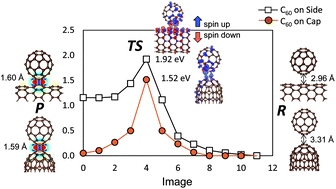Carbon nanobuds based on carbon nanotube caps: a first-principles study†
Abstract
Based on density functional theory calculations, we here show that the formation of a fullerene C60 carbon “nanobud” (CNB) on carbon nanotube (CNT) caps is energetically more favorable than that on CNT sidewalls. The dominant CNB formation mode for CNT caps is found to be the [2 + 2] cycloaddition reaction as in the conventional CNT sidewall case. However, it is identified to be exothermic in contrast to the endothermic reaction on CNT sidewalls. Computed reaction pathways further demonstrate that the formation (dissociation) barrier for the CNT cap-based CNB is slightly lower (significantly higher) than that of the CNT sidewall-based CNB, indicating an easier CNB formation as well as a higher structural stability. Additionally, performing matrix Green's function calculations, we study the charge transport properties of the CNB/metal electrode interfaces, and show that the C60 bonding to the CNT cap or open end induces resonant transmissions near the Fermi level. It is also found that the good electronic linkage in the CNT cap–C60 cycloaddition bonds results in the absence of quantum interference patterns, which contrasts with the case of the CNB formed on an open-ended CNT that shows a Fano resonance profile.


 Please wait while we load your content...
Please wait while we load your content...